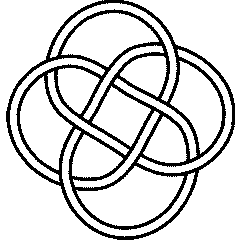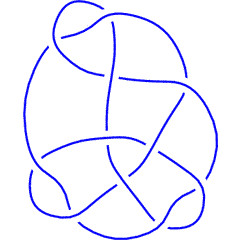The Alexander-Conway Polynomial: Difference between revisions
No edit summary |
No edit summary |
||
| Line 31: | Line 31: | ||
in = <nowiki>alex = Alexander[Knot[8, 18]][t]</nowiki> | |
in = <nowiki>alex = Alexander[Knot[8, 18]][t]</nowiki> | |
||
out= <nowiki> -3 5 10 2 3 |
out= <nowiki> -3 5 10 2 3 |
||
13 - t |
13 - t -- - -- - 10 t 5 t - t |
||
2 t |
2 t |
||
t</nowiki>}} |
t</nowiki>}} |
||
| Line 42: | Line 42: | ||
in = <nowiki>Expand[Conway[Knot[8, 18]][Sqrt[t] - 1/Sqrt[t]]]</nowiki> | |
in = <nowiki>Expand[Conway[Knot[8, 18]][Sqrt[t] - 1/Sqrt[t]]]</nowiki> | |
||
out= <nowiki> -3 5 10 2 3 |
out= <nowiki> -3 5 10 2 3 |
||
13 - t |
13 - t -- - -- - 10 t 5 t - t |
||
2 t |
2 t |
||
t</nowiki>}} |
t</nowiki>}} |
||
| Line 89: | Line 89: | ||
{{Knot Image Pair|K11a99|gif|K11a277|gif}} |
{{Knot Image Pair|K11a99|gif|K11a277|gif}} |
||
Sometimes two knots have the same Alexander polynomial but different Alexander ideals. An example is the pair [[K11a99]] and [[K11a277]]. They have the same Alexander polynomial, but the second Alexander ideal of the first knot is the whole ring <math>{\mathbb Z}[t]</math> while the second Alexander ideal of the second knot is the smaller ideal generated by <math>3</math> and by <math>1 |
Sometimes two knots have the same Alexander polynomial but different Alexander ideals. An example is the pair [[K11a99]] and [[K11a277]]. They have the same Alexander polynomial, but the second Alexander ideal of the first knot is the whole ring <math>{\mathbb Z}[t]</math> while the second Alexander ideal of the second knot is the smaller ideal generated by <math>3</math> and by <math>1 t</math>: |
||
<!--$${K1, K2} = {Knot[11, Alternating, 99], Knot[11, Alternating, 277]};$$--> |
<!--$${K1, K2} = {Knot[11, Alternating, 99], Knot[11, Alternating, 277]};$$--> |
||
| Line 119: | Line 119: | ||
n = 13 | |
n = 13 | |
||
in = <nowiki>Alexander[K2, 2][t]</nowiki> | |
in = <nowiki>Alexander[K2, 2][t]</nowiki> | |
||
out= <nowiki>{3, 1 |
out= <nowiki>{3, 1 t}</nowiki>}} |
||
<!--END--> |
<!--END--> |
||
Finally, the Alexander polynomial attains <!--$Length[Union[Alexander[#] |
Finally, the Alexander polynomial attains <!--$Length[Union[Alexander[#] |
||
<!--$$Length /@ {Union[Alexander[#]& /@ AllKnots[]], AllKnots[]}$$--> |
|||
<!--Robot Land, no human edits to "END"--> |
|||
{{InOut| |
|||
n = 14 | |
|||
in = <nowiki>Length /@ {Union[Alexander[#]& /@ AllKnots[]], AllKnots[]}</nowiki> | |
|||
out= <nowiki>{551, 802}</nowiki>}} |
|||
<!--END--> |
|||
Revision as of 07:44, 17 June 2007
(For In[1] see Setup)
|
| ||||||||
| ||||
 8_18 |
The Alexander polynomial and the Conway polynomial of a knot always satisfy . Let us verify this relation for the knot 8_18:
In[4]:=
|
alex = Alexander[Knot[8, 18]][t]
|
Out[4]=
|
-3 5 10 2 3
13 - t -- - -- - 10 t 5 t - t
2 t
t
|
In[5]:=
|
Expand[Conway[Knot[8, 18]][Sqrt[t] - 1/Sqrt[t]]]
|
Out[5]=
|
-3 5 10 2 3
13 - t -- - -- - 10 t 5 t - t
2 t
t
|
The determinant of a knot is . Hence for 8_18 it is
In[6]:=
|
Abs[alex /. t -> -1]
|
Out[6]=
|
45
|
Alternatively (see The Determinant and the Signature):
In[7]:=
|
KnotDet[Knot[8, 18]]
|
Out[7]=
|
45
|
, the (standardly normalized) type 2 Vassiliev invariant of a knot is the coefficient of in its Conway polynomial:
In[8]:=
|
Coefficient[Conway[Knot[8, 18]][z], z^2]
|
Out[8]=
|
1
|
Alternatively (see Finite Type (Vassiliev) Invariants),
In[9]:=
|
Vassiliev[2][Knot[8, 18]]
|
Out[9]=
|
1
|
 K11a99 |
 K11a277 |
Sometimes two knots have the same Alexander polynomial but different Alexander ideals. An example is the pair K11a99 and K11a277. They have the same Alexander polynomial, but the second Alexander ideal of the first knot is the whole ring while the second Alexander ideal of the second knot is the smaller ideal generated by and by :
In[10]:=
|
{K1, K2} = {Knot[11, Alternating, 99], Knot[11, Alternating, 277]};
|
In[11]:=
|
Alexander[K1] == Alexander[K2]
|
Out[11]=
|
True
|
In[12]:=
|
Alexander[K1, 2][t]
|
Out[12]=
|
{1}
|
In[13]:=
|
Alexander[K2, 2][t]
|
Out[13]=
|
{3, 1 t}
|
Finally, the Alexander polynomial attains







![{\displaystyle {\mathbb {Z} }[t]}](https://wikimedia.org/api/rest_v1/media/math/render/svg/97a786720fa81d7d0cf7400c3ff3f72e892fbc33)

